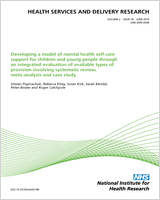Included under terms of UK Non-commercial Government License.
NCBI Bookshelf. A service of the National Library of Medicine, National Institutes of Health.
Tuffrey-Wijne I, Giatras N, Goulding L, et al. Identifying the factors affecting the implementation of strategies to promote a safer environment for patients with learning disabilities in NHS hospitals: a mixed-methods study. Southampton (UK): NIHR Journals Library; 2013 Dec. (Health Services and Delivery Research, No. 1.13.)

Identifying the factors affecting the implementation of strategies to promote a safer environment for patients with learning disabilities in NHS hospitals: a mixed-methods study.
Show detailsThis 21-month study (carried out between 2011 and 2013) aimed to describe the factors in NHS hospitals that promote or compromise a safe environment for patients with learning disabilities, in the light of national recommendations that hospitals should: identify patients with learning disabilities; provide reasonably adjusted services; involve carers as partners in care; and include patient and carer views in service development. Methods included questionnaire surveys, interviews and observation with senior hospital managers, clinical staff, patients and carers (a total of 1251 participants).
Examples of good practice were not consistently seen hospital-wide. The most common safety issues were delays and omissions of treatment and basic care. The main barriers to better and safer care were a lack of effective flagging systems, leading to a failure to identify patients with learning disabilities within hospitals; lack of staff understanding of learning disability issues; lack of effective carer involvement and staff misunderstanding of the carer role; and lack of clear lines of responsibility and accountability for the care of each patient with learning disabilities. The main facilitators of better care were learning disability liaison nurses (LDLNs) and ward managers.
The following further research is recommended: identifying the adjustments to hospital care that are most frequently needed by people with learning disabilities, and their cost implications; identifying the most effective structures for ensuring clear lines of responsibility and accountability for the care of patients with learning disabilities; investigating practical and effective ways of flagging patients with learning disabilities across NHS services and within NHS hospitals; investigating, implementing and evaluating procedures to ensure that family and other carers are involved in providing care; and evaluating LDLN posts nationwide.
- Plain English summary - Identifying the factors affecting the implementation of ...Plain English summary - Identifying the factors affecting the implementation of strategies to promote a safer environment for patients with learning disabilities in NHS hospitals: a mixed-methods study
- ribosomal protein S7 (plastid) [Achatocarpus nigricans]ribosomal protein S7 (plastid) [Achatocarpus nigricans]gi|1583105002|ref|YP_009557130.1|Protein
- HCG4P10 (0)GEO DataSets
Your browsing activity is empty.
Activity recording is turned off.
See more...